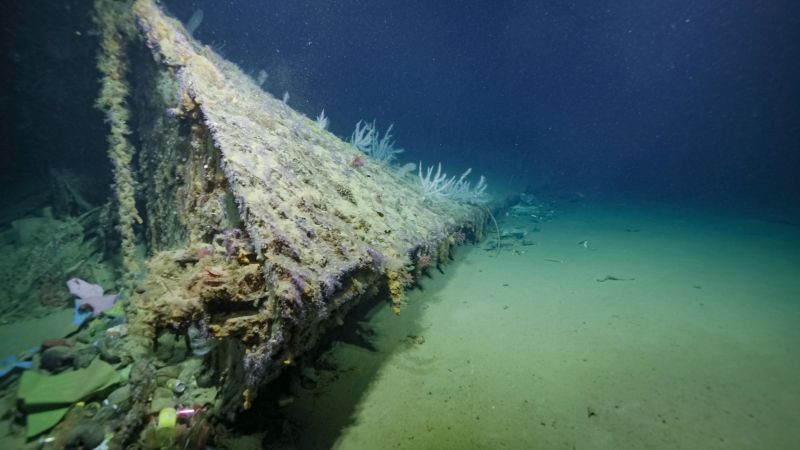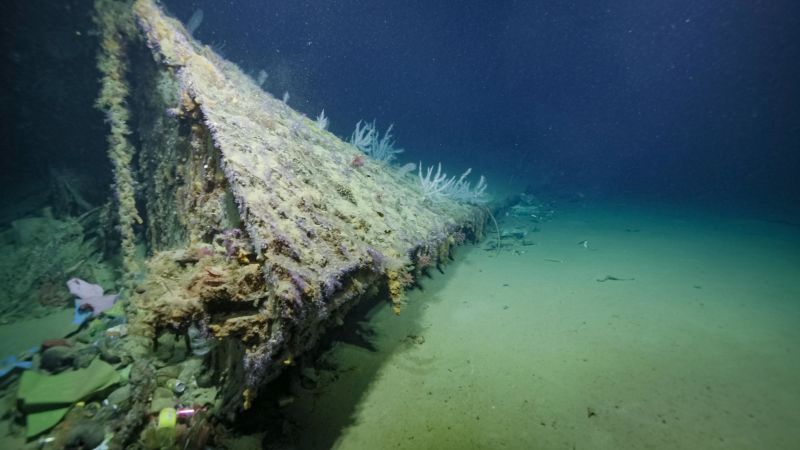
More than 80 years ago, the crew of the USS New Orleans, having been hit by a Japanese torpedo and losing scores of sailors, performed hasty repairs with coconut logs, before an 1,800-mile voyage across the Pacific in reverse.
The front of the ship, or the bow, had sunk to the sea floor. But over the weekend, the Nautilus Live expedition from the Ocean Exploration Trust located it in 675 meters (2,214 feet) of water in Iron Bottom Sound in the Solomon Islands.
Using remotely operated underwater vehicles, scientists and historians observed “details in the ship’s structure, painting, and anchor to positively identify the wreckage as New Orleans,” the expedition’s website said.
On November 30, 1942, New Orleans was struck on its portside bow during the Battle of Tassafaronga, off Guadalcanal island, according to an official Navy report of the incident.
The torpedo’s explosion ignited ammunition in the New Orleans’ forward ammunition magazine, severing the first 20% of the 588-foot warship and killing more than 180 of its 900 crew members, records state.
The crew worked to close off bulkheads to prevent flooding in the rest of the ship, and it limped into the harbor on the island of Tulagi, where sailors went into the jungle to get repair supplies.
“Camouflaging their ship from air attack, the crew jury-rigged a bow of coconut logs,” a US Navy account states.
With that makeshift bow, the ship steamed – in reverse – some 1,800 miles across the Pacific to Australia for sturdier repairs, according to an account from the National World War II Museum in Louisiana.
“‘Difficult’ does not adequately describe the challenge,” Schuster said.
While a ship’s bow is designed to cut through waves, the stern is not, meaning wave action lifts and drops the stern with each trough, he said.
When the stern rises, rudders lose bite in the water, making steering more difficult, Schuster said.
And losing the front portion of the ship changes the ship’s center of maneuverability, or its “pivot point,” he said.
“That affects how the ship responds to sea and wind effects and changes the ship’s response to rudder and propellor actions,” he said.
The New Orleans’ officers would have had to learn – on the go – a whole new set of actions and commands to keep it stable and moving in the right direction, he said.
The ingenuity and adaptiveness that saved the New Orleans at the Battle of Tassafaronga enabled it to be a force later in the war.
After making it across the Pacific from Australia to the US naval yard at Puget Sound, Washington state – facing the right way this time – the New Orleans undertook permanent repairs. It later participated in actions across the Pacific, including the decisive battles of Saipan and Okinawa, which led to the US gaining airfields that enabled the final blows to be made on Imperial Japan.
The ship was awarded 17 battle stars for its actions in the Pacific, tying it for the third most such decorations in the Pacific theater, according to the World War II Museum.
The New Orleans’ bow was found during the 21-day Maritime Archaeology of Guadalcanal expedition of Iron Bottom Sound by Nautilus Live, a cooperative effort among NOAA Ocean Exploration, the Ocean Exploration Cooperative Institute, the University of New Hampshire and the Naval History and Heritage Command.
Iron Bottom Sound was called Savo Sound before World War II, but Allied sailors gave it its current moniker for the huge numbers of warships that sank in battle there.
According to the expedition, five major naval battles were fought there between August and December 1942, resulting in the loss of more than 20,000 lives, 111 naval vessels and 1,450 planes on all sides.
Before the expedition, “fewer than 100 of these US, Japanese, Australian, and New Zealand military ships and planes have been located,” it says on its website.
The expedition began on July 2 and continues until July 23. Its continuing searches are being live streamed at nautiluslive.org.


